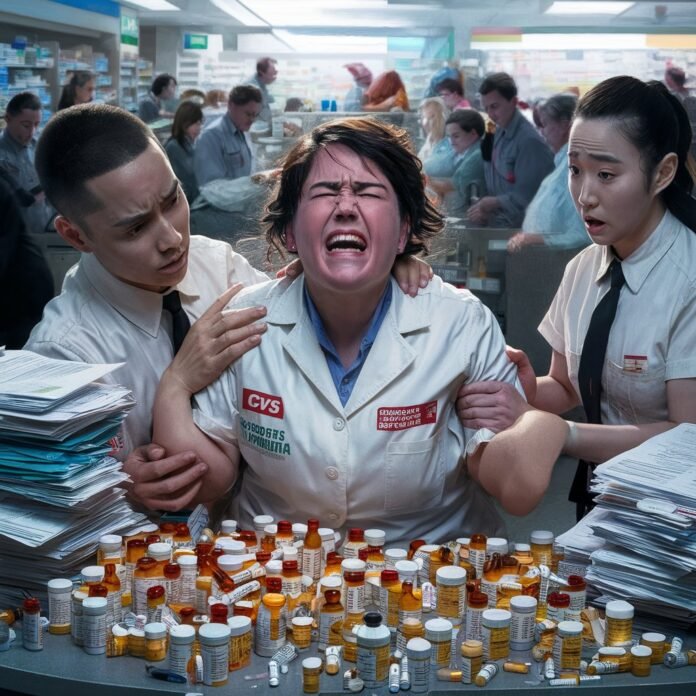Introduction
A recent viral video capturing a CVS pharmacist having an emotional breakdown during their shift has sparked a nationwide conversation about the immense pressures facing pharmacy professionals. The distressing footage—which shows the pharmacist overwhelmed by understaffing, endless prescriptions, and impatient customers—is not an isolated incident but rather a glaring symptom of systemic issues plaguing retail pharmacies. As corporate chains prioritize profits over patient care, pharmacists are pushed to their breaking points, forced to navigate unrealistic workloads, insurance complexities, and a lack of support. This article examines the root causes behind such meltdowns, the human cost of pharmacy burnout, and what must change to protect both healthcare workers and the communities they serve.
1. The Breaking Point: What Led to the CVS Pharmacist Meltdown?
The now-viral incident did not happen in a vacuum—it was the inevitable result of an industry stretched to its limits. Retail pharmacists today are expected to fill hundreds of prescriptions daily while simultaneously administering vaccines, answering patient questions, and dealing with insurance complications—all within 12-hour shifts that often include no breaks. Corporate metrics prioritize speed over accuracy, leaving pharmacists torn between corporate demands and patient safety. Many report being the only pharmacist on duty for an entire store, managing both drive-thru and in-person orders while under constant pressure to meet performance quotas. The CVS meltdown was not a personal failure but a structural one, revealing a system that prioritizes efficiency over employee well-being.
2. Pharmacy Burnout: An Industry in Crisis
The emotional toll on pharmacists has reached crisis levels, with studies showing that nearly 60% of retail pharmacists experience severe burnout. Long hours, understaffing, and the emotional weight of handling life-or-death medications have led to skyrocketing turnover rates. Many pharmacists report anxiety, depression, and even PTSD-like symptoms from the relentless stress. The profession, once seen as stable and respected, is now facing a mass exodus of talent as experienced pharmacists leave for less stressful roles in hospitals or leave the field altogether. The CVS meltdown video resonated because it was not an outlier—it was a raw, unfiltered glimpse into the daily reality of countless pharmacy workers.
3. Corporate Responsibility: How CVS and Walgreens Fuel the Problem
Critics argue that corporate pharmacy chains like CVS and Walgreens bear significant blame for the deteriorating work conditions. To maximize profits, these companies have cut staffing to dangerous levels, increased prescription quotas, and implemented rigid performance metrics that leave no room for human error. Pharmacists report being denied bathroom breaks and pressured to skip safety checks to meet corporate targets. Meanwhile, executives continue to post record profits while frontline workers struggle. The CVS meltdown has amplified calls for unionization, federal oversight, and mandated staffing ratios to hold these corporations accountable.
4. Patient Safety at Risk: The Hidden Dangers of Overworked Pharmacists
When pharmacists are pushed beyond their limits, patient safety becomes collateral damage. Studies link pharmacist burnout to higher medication error rates, including incorrect dosages or dangerous drug interactions. In one harrowing case, an exhausted pharmacist misfilled a prescription, leading to a patient’s hospitalization. Yet, rather than addressing the root causes, corporate chains often blame individual pharmacists for mistakes caused by systemic failures. The CVS meltdown should serve as a wake-up call: A broken pharmacy system doesn’t just harm workers—it endangers public health.
5. Solutions: How to Fix the Pharmacy Industry Before More Meltdowns Happen
The crisis demands immediate action on multiple fronts:
- Federal & State Legislation: Mandate minimum pharmacist-to-technician ratios and enforce break requirements.
- Corporate Reform: CVS, Walgreens, and other chains must increase staffing, reduce prescription quotas, and prioritize safety over profits.
- Pharmacy Unions: Empower pharmacists to collectively bargain for better conditions.
- Public Awareness: Customers must recognize their role—patience and advocacy can pressure corporations to change.
Conclusion: A System on the Verge of Collapse
The CVS pharmacist meltdown was not just a viral moment—it was a desperate cry for help from an industry on the brink. If corporations and policymakers fail to act, more pharmacists will break down, more errors will occur, and more lives will be at risk. The solution starts with valuing pharmacists not as cost-cutting liabilities but as essential healthcare providers deserving of dignity, support, and safe working conditions. The time for change is now—before the next meltdown becomes a tragedy.



